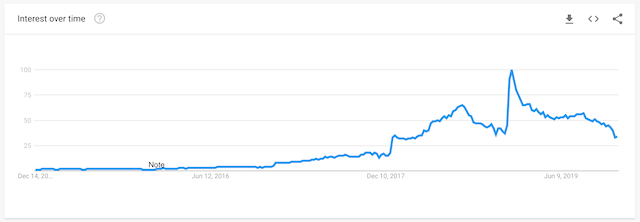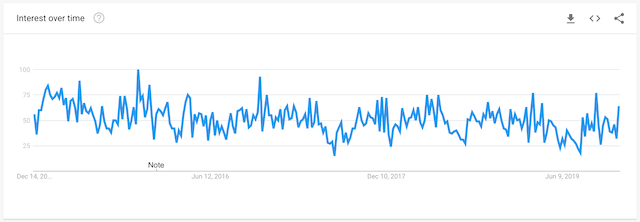
Are you tired of seeing your visitor stats bounce up and down from week to week? Do your new blog posts stop bringing in new readers after a day or two? Does it feel like you spend all of your time writing new content without getting any traction?
You might need an evergreen content fix.
Why Produce Evergreen Content?
Just like the fir tree needles that never change color, evergreen content is relevant and useful year-round. It’s the content that readers never get tired of.
Typically, evergreen content is longer-form, simply because it explores a topic in depth. Regardless of the length, it provides the reader with a rich perspective and information.
But why take the time to produce evergreen content?
This content has long-term value. Usually, evergreen content tackles big questions or topics in a niche. It will keep bringing new readers to your blog for weeks, months or even years after you’ve written it. And, because it gives your readers so much value, it’s more likely to convert them to regular readers or email list subscribers.
It’s also fairly stable from a search engine perspective. A blog built from evergreen content should have a steady stream of traffic rather than a series of spikes and lows created with the interest swings of time-sensitive content.
Finally, it has greater value potential for repurposing into other formats. With time-sensitive content, you only have a certain window to take advantage of the trend. Which, if you’re trying to transform a blog post into multiple other formats (a podcast, a Slideshare, an eBook, etc.), means your creation timeline is compressed. Once it’s created, it has a set life expectancy. And when the trend is dead, you have to create an entirely new line of content for the next trend, which keeps you on the hamster-wheel of content creation.
Evergreen content doesn’t have this problem. Once you’ve created your first piece of content, you can repurpose it into as many other formats as you want, when you want. You don’t have to worry about potential readers suddenly losing interest. Plus, since the information is a constant, you can spend more time on editing the content and improving its appearance, carefully tailoring it to meet best practice for each format.
So all of this sounds too good to be true, right? There’s got to be a catch to this evergreen content somewhere.
Well, there is. Evergreen content is dependable, but it isn’t the flashy or exciting topic du jour. You know, the thing everyone is talking about right now. So, it’s not quite as likely to go viral as trend-chasing content.
There’s also the frustration factor of a slower return on investment. Evergreen content won’t produce an audience for you overnight. Instead, the work will compound over time. It may take weeks or even months to see a return on the effort you’ve put in.
Because it doesn’t have the trendy interest-grabbing factor, evergreen content must also be incredibly solid from a value perspective. Your reader has to say: This article taught me so much! It’s amazing.
So for evergreen content, the ideas and the writing have to be the absolute best you’re capable of producing. Otherwise, it could be dismissed as another low-value article junking up the internet and relegated to the dreaded third-plus page of search results.
Evergreen content also takes much more time and effort to produce. You’re not cranking out some surface-scratching 350-word article for the content mill. You’re creating a long-form, information-dense piece that will stand the test of time, which requires deep research, thoughtful outlining and careful editing. Overall, it’s a longer production time-frame.
But more work invested up-front means a greater lifetime value and less time spent on the trend-chasing content production hamster wheel.

Finding Evergreen Topics
So you’re sold on the value of evergreen content. But you’re running into one major stumbling block:
What are you supposed to write about that’s evergreen?
Evergreen content topics will vary from niche to niche. But there are a few ways to brainstorm topics that apply to almost any area. Consider the following:
1. Go Back to the Beginning
What are the topics in your niche that newcomers always ask about? If you had to explain your area to someone brand-new to the topic, what would you explain first? Or if you could go back and time and give yourself advice when you just started in a niche, what would you say? Because hopefully you’ll always have new folks in your niche, these basic explanatory pieces can be a source of permanent traffic.
2. Find Your Soapbox
What’s something everyone in your niche needs to know? What are the topics you are willing to get a bit ranty on? What doesn’t get talked about enough in your field? Taking a stand on a topic always resonates and passion is definitely evergreen fodder.
3. Pursue Eternal Truths
What’s going to be true in your field no matter what happens? What will never change? In a hundred years, what topics will people in your niche still be debating? This is great for sparking more idea-driven pieces that are more theory than application.
If this isn’t quite enough to get your gears going, think of the flip-side: what makes content trendy?
- Is it suddenly on the news everywhere? Probably trendy.
- Is it associated with a “fad” or “craze” that’s popped up from nowhere? Definitely trendy.
- Is it about a new product/service/recent announcement or unveiling? It might be trendy.
Fortunately, if you’re still on the fence on whether you’re onto an evergreen topic, there is one potential “cheat.”
The Google Trends Cheat
Consider this the data-driven evergreen vs. time-sensitive test.
Visit Google Trends to search your topic. Set the timeline range to a minimum of three years (though five years or longer is better). Now, search your intended topic. While you’re searching, use Google’s refinement tools. They’ll help the trend tool know if you’re searching for an apple fruit or for Apple the company.
If your graph looks like this, it's time-sensitive:

Note that drop-off after the spike. That’s the trend’s die-off point. And your trendy content, unfortunately, dies with it.
Instead, what you want to see is a graph that looks like this:

Sure, there are peaks and valleys. But it’s all staying within a fairly predictable range. You’re not seeing a sudden surge uptick in interest or steep drops.
Remember, evergreen content is reliable. But, once you have your topic in mind, there are a few caveats to keep in mind with the writing process.
Evergreen Writing Essentials
Evergreen content is like the tortoise from the fable: it’s slow and steady. So, there are some different considerations necessary when writing this kind of content.
First, set aside plenty of time for research and planning. Evergreen content has to be highly valuable to “make it” on the wider web. A laser focus and citing plenty of sources through links can only help make your case (and your search engine value). Don’t rush this part of the process. Set up a stable foundation before you start your writing.
Second, realize your writing process may take longer than usual. To make an article evergreen, you have to set aside time for research. You’ll also be working on long-form pieces, which naturally take more time to produce. And you might have to iterate through a few more drafts or spend more time on the polishing, editing and formatting phases to ensure the article is top-quality.
So, you’ll need to adjust your expectations on the number of evergreen articles you can publish within a certain time-frame.
Most likely, you won’t be producing evergreen content daily unless you’re a full-time professional writer with no other work demands. For the prolific writers among us, two to three times a week may be attainable. But for the rest of us, our timelines will need to be a bit longer. Depending on how much time you have to write, that may range from once a week to once a month.
Don’t beat yourself up if you’re not producing as much as usual. What you’re not putting into quantity is going into superior quality.
Third, don’t forget to make the most out of your content by repurposing. Evergreen content is an investment of time and writing resources. If you’re not repurposing content into multiple formats, you’re still chaining yourself to the content production hamster wheel.
Finally, be patient. It takes time to see the real results from evergreen content, especially if you’re just starting out with a blog or don’t have a large following. You may not have the viewing or reading booms associated with trendy viral articles, even if you’re promoting your articles as usual.
But, over weeks and months, you’ll see your efforts compound. You’ll get steady traffic from your articles and the repurposed formats. As more people join your following, your evergreen content will spread faster.
Eventually, the process becomes a self-reinforcing loop that builds a loyal base of fans—and all you have to do to keep the flywheel spinning is write.
The Evergreen Checklist
There’s a lot to keep in mind when writing evergreen content. So, we’ve put together a quick checklist for evergreen content production:
1. Determine your evergreen article frequency. Figure out how often you’ll publish evergreen content. Don’t forget to factor in a longer time-frame.
2. Plan your process. Plan your entire writing process (from preliminary research, to rough drafting, to editing and formatting) to match your time-frame.
3. Research, write, edit, format. The meat and potatoes of the evergreen process. It’s like writing any other article, just taking a more in-depth approach.
4. Publish and promote. Hit the publish button. Start sparking interest in your articles by promoting them to your current followers.
5. Repurpose and re-promote. Transform the content into other formats. Continue promoting the other formats on the appropriate platforms.
Repeat these steps for each evergreen article and simply wait for the benefits to set in. In time, you’ll have a content forest of fir trees for new readers to explore.

